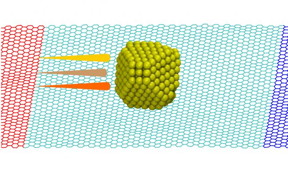From hot to cold: How to move objects at the nanoscale: Moving a single gold nanocluster on a graphene membrane, thanks to a thermal gradient applied to the borders: a new study sheds light on the physical mechanisms driving this phenomenon
To move a nanoparticle on the surface of a graphene sheet, you won't need a "nano-arm": by applying a temperature difference at the ends of the membrane, the nanocluster laying on it will drift from the hot region to the cold one. In addition, contrary to the laws ruling the world at the macroscale, the force acting on the particle -- the so-called thermophoretic force -- should not decrease as the sheet length rises, sporting a so-called ballistic behavior, same as a bullet in a gun barrel. In fact, simulations show that vertical thermal oscillations of the graphene membrane flow ballistically from hot to cold, providing a push to the object. Yet, these vertical waves, known as flexural phonons, should not be able to impress any lateral shift to an object. Nevertheless, computer simulations show that they do push the nanocluster in the same way a surfboard is taken to shore by ocean waves. And, of course within limits, no matter how far away the wave came from. These theoretical predictions could be of great interest in the frame of manipulating materials at the nanoscale, in view of potential technological applications.
"Temperature gradients in a fluid impart on a body a force that can displace it: such a phenomenon, technically referred to as thermophoresis, has been known for centuries. More recently, numerical simulations have indicated that such a gradient-induced spatial shift also works for molecules or small clusters placed on a solid two-dimensional membrane like graphene. But no one ever tried to deeply understand the physics behind the process. This was the aim of our study," the scientists explain.

The theoretical predictions of these study could be of great interest in the frame of manipulating materials at the nanoscale for technological applications.
Using specific software, the researchers have simulated the behaviour of a tiny gold nanocluster, made of a few hundred atoms, adsorbed on a graphene sheet suspended between two ends with different temperatures.
"In such a condition, the particle actually moves from the hot to the cold end. Surprisingly, though, the thrust impressed to it only depends on the thermal gradient and not on the sheet length," say the researchers. So, it is shown that the distance between the two ends of the membrane has no influence on the force acting on the gold cluster, force which remains constant up to and beyond a 100-nanometer sheet length. "We have named this peculiar thermophoresis ballistic, to distinguish it from the diffusive one which naturally holds in the macroscopic world. Using a simple metaphor, imagine the two ends of the graphene sheet as the top and the bottom of a slide at the playground, and the temperature difference as the height gap. In the macroscopic world we experience in our everyday life, the closer the ends of the slide are, the faster the drop of the object will be. In the nanoworld, according to our simulations, this is not what happens. At this scale, force and dropping speed only depend on the temperature gradient. But not on the distance." "We have found that the force experienced by the particle is due to vertical thermal movements, known as flexural phonons, which are particularly wide and soft in a graphene membrane. The flexural phonons flux flows from hot to cold without losing strength and pushing the object over the surface," the scientists continue.
Hold on. How can such vertical thermal waves give a horizontal push to the gold cluster? "Our study shows that a precise anharmonic mechanisms plays a crucial role in graphene and in other two-dimensional flexible membranes. This mechanism provides flexural phonons with mechanical momentum, which they usually don't have. Acting as if they carry a mass, phonons transfer part of their momentum to the gold particle, inducing it to move." The researchers continue to explain: "It's exactly like a tablecloth on a table: a corrugation in the centre (the flexural phonons), meaning higher cloth density in the centre, forces the extremes to contract (the longitudinal phonons, in the case of graphene). The deposited particle is only sensitive to the corrugation, which pushes it forward."
"When this project started we were not expecting to be able to observe such a variety of phenomena, it was a purely theoretical study. Our results, though, can now open the way to future experiments, as a distance-independent mechanical force could well possess practical applications," they conclude.
Source: Nanotechnology Now
- 418 reads
Human Rights
Ringing FOWPAL’s Peace Bell for the World:Nobel Peace Prize Laureates’ Visions and Actions

Protecting the World’s Cultural Diversity for a Sustainable Future

The Peace Bell Resonates at the 27th Eurasian Economic Summit

Declaration of World Day of the Power of Hope Endorsed by People in 158 Nations

Puppet Show I International Friendship Day 2020

